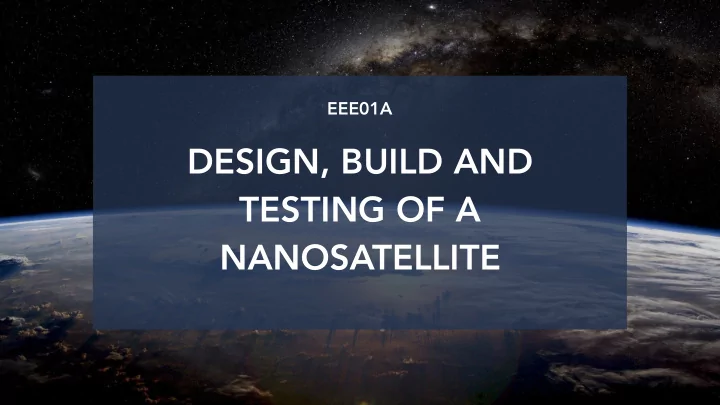

EEE01A DESIGN, BUILD AND TESTING OF A NANOSATELLITE
Introduction to CubeSats KEY POINTS Satellite Communication Characteristics of Satellite Orbits Background on Orbital Mechanics SCOOB-I 3U CubeSat Systems T ool Kit (STK) Results and Discussion Conclusion
WHAT ARE CUBESATS?
CUBESAT SUBSYSTEMS • Communications with the ground station [COMM] • On-Board Data Handling and Storage [OBDH] • Attitude Determination and Control System [ADCS] • Electrical Power System [EPS] • Mechanical Structure and Thermal Control System • Payload
CUBESAT SUBSYSTEMS MISSION DESIGN OF THE SATELLITE
SATELLITE COMMUNICATION Downlink With ground contact, this would allow the ground station to send radio signals and command to the satellite while receiving data transmission for further analysis.
CHARACTERISTICS OF SATELLITE ORBITS THE 2 TYPES: 1. Low-Earth Orbit (LEO) 2. Equatorial Orbit
LOW-EARTH ORBIT EQUATORIAL ORBIT satellites are at the altitude of between satellites orbit near the meridian line 160 to 2,000km above Earth’s surface
BACKGROUND ON ORBITAL MECHANICS
i. Semi-major axis (a) ii. Eccentricity (e) ORBITAL iii. Inclination (i) iv. Argument of Perigee ( ω ) ELEMENTS v. Right Ascension of the Ascending Node ( Ω ) vi. True Anomaly ( ν )
Mission Design of a 3U CubeSat SCOOB-I SATELLITE Scheduled for launch in 2020
OBJECTIVES OF THE SATELLITE 1. To measure the solar irradiation in the infrared and visible part of the solar spectrum 2. To determine the ionization radiation at 400 km or above in order to validate and verify first-principles aviation radiation models.
METHODOLOGY By applying the theory of orbital mechanics, fixed values of data such as orbit altitude are chosen. Additionally, an inclination range of 5° to 15° is used for comparison. Using the Systems Tool Kit (STK), orbit simulations are generated with the aforementioned values to find out parameters such as the solar intensity as well as the ground contact period. Analyses are made using the reports and graphs that are computed to determine which inclination is the most beneficial for the Singapore ground station.
SYSTEMS TOOL KIT (STK)
STK SIMULATIONS • A simulation of the satellite orbit is created using STK, which projects a satellite ground track. • Using STK, different graphs and reports can be generated to find out the suitability of the inclination.
RESULTS & DISCUSSION
Sun Vector BETA ANGLE Satellite’s Projection of Sun vector onto orbital plane orbital plane
BETA 40 ANGLE 30 used for further 20 calculations to determine the 10 thermodynamic properties of the 0 satellite in space. Item 1 Item 2 Item 3 Item 4
ACCESSIBILITY OF THE SATELLITE
NUMBER 40 OF CONTACTS 30 Inclination Number of Contacts a contact occurs 5° 2550 20 when the satellite 10° 2550 passes directly 10 overhead the 15° 2549 Singapore ground 0 station along the Item 1 Item 2 Item 3 Item 4 ground track.
DURATION 40 OF CONTACTS 30 used to calculate the 20 communication window per day 10 between the satellite and the 0 Singapore ground Item 1 Item 2 Item 3 Item 4 station.
DURATION 40 OF CONTACTS 30 Average Contact Period Inclination per Day/s used to calculate the 5° 11400 20 communication window per day 10° 11000 10 between the 15° 10300 satellite and the 0 Singapore ground Item 1 Item 2 Item 3 Item 4 station.
SOLAR INTENSITY
SOLAR 40 INTENSITY 30 the percentage 20 of the solar disc visible to the 10 satellite. 0 Item 1 Item 2 Item 3 Item 4
ECLIPSE DURATION
ECLIPSE DURATION 40 30 eclipsing events are the start and 20 end periods of penumbra and 10 umbra. Item 4 0 Item 1 Item 2 Item 3
ECLIPSE DURATION 40 Average Eclipse Duration Inclination 30 per Day/s eclipsing events 5° 2125 are the start and 20 end periods of 10° 2129 penumbra and 15° 2131 10 umbra. Item 4 0 Item 1 Item 2 Item 3
CONCLUSION
CONCLUSION 5° inclination for the SCOOB-I CubeSat is the most effective parameter for Singapore ground station because: • it has the longest communication period for more data download. • it has the least eclipse duration, allowing for a shorter period of power loss.
Thank You for your kind attention!
Recommend
More recommend